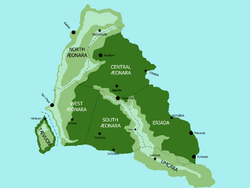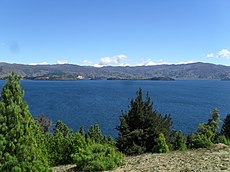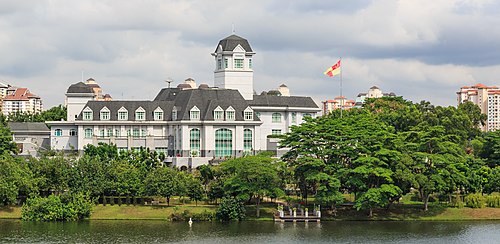Æonara: Difference between revisions
m (→Education) |
m (→Gallery) |
||
| Line 157: | Line 157: | ||
| [[File:Newe Daniel 042314.JPG|thumb|upright|alt=idk, some shit|A typical "settlement town" in West Æonara]] | | [[File:Newe Daniel 042314.JPG|thumb|upright|alt=idk, some shit|A typical "settlement town" in West Æonara]] | ||
| [[File:Tota Lake 1.JPG|thumb|upright|alt=idk, some shit|H]] | | [[File:Tota Lake 1.JPG|thumb|upright|alt=idk, some shit|H]] | ||
| [[File:UKZN.jpg|thumb|upright|alt=idk, some shit|Cabinet Secretariat Building, | | [[File:UKZN.jpg|thumb|upright|alt=idk, some shit|Cabinet Secretariat Building, [[Cities of Kiravia#New_Kartika|New Kartika]] ]] | ||
|- | |- | ||
| [[File:Biscayne Boulevard south end.jpg|thumb|upright|alt=Downtown Prevarda|H]] | | [[File:Biscayne Boulevard south end.jpg|thumb|upright|alt=Downtown Prevarda|H]] | ||
Revision as of 10:23, 24 November 2023
 | |
| Geography | |
|---|---|
| Location | East Crona Sea, Ixnay |
| Adjacent bodies of water | Æonara Sound |
| Total islands | 7 |
| Major islands | 2 |
| Administration | |
| Federal subjects | |
| Largest settlement | Sirana (pop. 1,240,420) |
| Demographics | |
| Demonym | Æonaran |
| Population | 69,180,000 |
| Ethnic groups | 64.4% Coscivian (Æonaran, Umcaran, other) 24.5% Sinyolan |
| Additional information | |
| Time zone |
|
Æonara (/aɪʲ.oː.na.ra/) is a continental island off the northeastern coast of Crona. Along with its smaller sister island of Tævuon, Æonara was colonised by Coscivians from 20762 and has been governed in its entirety by the Kiravian Federacy and its predecessors since the 20780s. The island is divided among the Kiravian states of Central Æonara, North Æonara, South Æonara, West Æonara, and Umcara, as well as the Kiravian territory of Tævuon.
Geography
Æonara is laid out roughly in the form of a scalene triangle, extending from the Kanaveron Peninsula in North Æonara south to Xsādiróva, West Æonara and southeast to Kesta Kobra, Umcara. Tævuon lies just to the southeast of the main island, separated by the Tævuon Strait. The most prominent landforms on the island are two mountain ranges, the Emerald Mountains, which trace along the northern and western coast, and the Jade Mountains, which rise near the geographic centre of Æonara and continue in a southeasterly direction toward Kesta Kobra.
Æonara is well within the tropical belt has a tropical climate overall, though with altitudinal variation. Many lowland areas east of the Jade and Emerald mountains (i.e. in Central Æonara and Eriada) have a tropical maritime climate, as do some areas directly on the southern coast. Other lowland areas generally have a more classical tropical wet-and-dry climate. Upland areas exhibit variations on a subtropical highland climate with more moderate temperatures. Locally there are three customatry gradations of the different life zones resulting from this altitudinal variation, known in Æonaran Coscivian as the bréaśad ("hot land"), lúaśad ("mild land"), and thóaśad ("cool land").
Important cities in Æonara include Sirana, Sar-i-Paul (Saripáuv), Prevarda, Saravena, Vaśyansar, and Ærhorn.
 |
 |
 |
 |
 |
 |
History
The history of Æonara is closely intertwined with that of the Cape.
[Pre-Coscivian History]
Colonial History
[Colonial History]
United Empire Loyalism
Kiravian military supremacy and political control was more complete and secure over Æonara, as a relatively smaller offshore landmass (along with Tævuon, an even smaller island), than on the South Cronan mainland, and as such, it was regarded as a safer destination for aspiring smallholders and families emigrating from Great Kirav. By the time of the National Revolution in the Cape, around three-quarters of the population of Æonara were either mestiço or Coscivised Cronite Kolakoskem ("Land Coscivians") or creole Farakoskem ("Sea Coscivians") of Kiravian extraction; a markedly higher proportion than on the Mainland. For this reason and others, the revolutionary spirit did not burn brightly in Æonara, which emerged as a key Loyalist stronghold.
After the success of the National Revolution and the Kiravian withdrawal from the Cape, Æonara was flooded with Loyalist emigrés and became the new base for government bureaux and numerous commercial enterprises previously located in Cape Town.
The Loyalist emigrés tended to be of an archconservative and Coscivian imperialist mindset and were staunchly opposed to modernist ideologies such as nationalism and socialism. Keen on preventing the revolution in the Cape from replicating itself in Æonara or the other colonies, prominent Loyalists organised themselves into a fraternal association, the United Empire Loyalists, through which they and their descendants would become an eminent political and social force in Æonara until the Sunderance, after which they would continue to influence the ruling Renaissance Party.
Kiravian Remnant
When the Kirosocialist Party promulgated a new constitution establishing single-party rule, opposition forces denounced the new constitution as illegitimate, and non-Kirosocialist Delegates led by the Renaissance Party convened a rump Stanora in Vaśyansar, North Æonara. With the backing of conservative elements in the Kiravian armed forces and civil service who refused to serve the new régime on the mainland, as well as partisan militia, the rump Stanora organised a government-in-exile in Æonara under the leadership of Séan Kæśek as Prime Executive.
Post-Kirosocialism
The decade immediately following the consummation of Kiravian Reunification was difficult and turbulent for Æonara, and is remembered as a time of bittersweet zeitgeist due to the conflicting emotions surrounding, on one hand, achievement of the overarching National mission around which so much of modern Æonaran culture had been organised, and on the other the loss of Æonara's central position within the Kiravian Federacy and Coscivian world as a direct consequence of this success.
The mixed implications of reunification for the Æonaran economy - which had formed the core of the economy of the Kiravian Remnant - were evident from the very beginning. As progress in reunification negotiations became public knowledge, investor confidence in certain segments of the Remnant's economy, most acutely real estate, higher-order industries within the high technology sector, the defence industry, and primary sector industries reliant on resources in Atrassica and Cusinaut, began to waver, while confidence in the financial sector hit a fever pitch. Market actors anticipated (correctly) that the the merger of the two Kiravian economies would entail significant structural adjustments. Despite the vastly increased potential for long-term growth by extension of the Remnant's successful economic and political systems over the enormity of Great Kirav, there were well-founded concerns that in the near-term that Æonara's well-established market-oriented economy was essentially taking on a gargantuan, severely distressed asset in the form of the Mainland's imploded command economy, and that the demands of the transition would be a massive drag on Æonara's own efficiency and productivity.
As predicted, reunification brought on dramatic changes to Æonaran trade dynamics. Æonara had by then been punching above its weight in global trade for several decades, and a reunification redirected the patterns of its commercial relations away from its established foreign trading partners and peripheral overseas colonies and toward the opening Mainland market. Integration with the Kiravian Mainland provided access to a massive, thitherto untapped domestic market, presenting new opportunities for Æonaran businesses, especially those selling consumer and light capital goods, and professional services. On the flipside, it also decimated many local Æonaran industries (such as bauxite and coal mining), and killed critical public subsidies to strategically-important sectors and to industries oriented toward exports to other advanced economies, these government funds being needed to finance the political transition and economic reconstruction on the Mainland. Foreign direct investment patterns were also similarly affected: Æonara had been a major beneficiary of significant foreign investment due to its stable political environment and robust economic fundamentals. Reunification and liberalisation of the former Kiravian Union altered the perception of Æonara as a separate investment destination from the Mainland, resulting in the redirection of some foreign investment towards Great Kirav-based enterprises, largely at the expense of Æonara's FDI inflows. However, the attractiveness of Æonara's skilled workforce, technological capabilities, and transparent legal framework did help to retain and attract foreign investment, even in the midst of such changes.
After Reuinification had been fait accompli for a few years, its economic and social impact became more visible and tangible to the average Æonaran, especially so when it came in the form of enterprise relocations and job losses. During the Civil War, many major antebellum Kiravian corporations, for example the Bay Trading Company, had fled Great Kirav and established new headquarters on Æonara from which they continued their operations. After Reunification, most of these corporations returned their headquarters to the Mainland, and even some companies founded on Æonara moved their main offices to Great Kirav to gain a more secure foothold in the rapidly opening business landscape there. Hundreds of thousands more jobs (and billions in public expenditure) left Æonara as the Federal government gradually moved its bloated bureaucratic apparatus back to Kartika. The knock-on effects of this move for local economies and for sectors such as education were negative and severe.
Politics and Governance
Æonara is divided among seven Kiravian federal subjects: Six states - Central Æonara, North Æonara, South Æonara, West Æonara, Eriada, and Umcara - and one territory - Tævuon. During the Sunderance, the Kiravian federal government became more directly involved in governance of the island, resulting in a more *de facto* centralist arrangement described today as "strong federalism" (lādivuntiārkarisēn). Several other federal subjects existed on Æonara during the Sunderance, including the Vaśyansar Federal District in present-day North Æonara, which contained the seat of the federal government, and several smaller provinces erected on the territory of Central Æonara and Eriada as part of Rump Republic's "creative constitutionalism". After the federal seat of government returned to the mainland, an Æonaran Council based in Sirana and headed by the seven provincial Governors took over many interstate functions left behind and facilitates inter-province coöperation. The seven provincial defence forces in Æonara operate as an Æonaran Battlegroup with a joint command structure.
Æonara is regarded as a solidly conservative region that has historically rejected revolutionary movements such as Bannerism, Novialism, Kirosocialism, communism, and the national-revolutionary Restarkism prevailing in its neighbour, the Cape. Æonara reliably elects slates of Delegates that sit with the Shaftonist-Republican Alliance and Authentic Historical Caucus in the Federal Stanora. Politics in the individual states tends to be dominated by the local chapter of the Renaissance Party.
Society and Culture
Æonara has a Coscivian culture shaped by the rich heritage of Coscivian traditions transplanted by Kiravian settlers, as well as influences from the indigenous peoples absorbed and subsumed into the settler society, particularly as regards foodways, agricultural techniques, and the culture's relationship to its natural environment.
The Æonaran Coscivians, who trace their ancestry back to the first and (to a lesser degree) second waves of Coscivian settlers, form the largest ethnic group on the island. They share most of their culture in common with the Umcaran Coscivians. Their language, Æonaran Coscivian, is characterised by many archæic and divergent features that differentiate it from modern Kiravic Coscivian (with which it is not mutually intelligible), as well as by a great many loanwords from local Cronan languages. It is an official language in all states of Æonara; and is spoken natively by an outright majority of the population in South Æonara. There are numerous communities, castes, and subgroups within the Æonaran Coscivian population, with different traditional lifestyles, dialects, and degrees of admixture with the indigenous peoples. The second largest Coscivian ethnic group on the island are the closely related Umcaran Coscivians, concentrated in South Æonara and Umcara. A large share (35-50%) of Æonaran Coscivians and all Umcaran Coscivians can be considered Kolakoskem ("Land Coscivians").
The turmoils of [whatever the 20th century is] brought new waves of Coscivian migration to Æonara, first Kiravian loyalist refugees from the Cape after that country's independence, and later anti-communist refugees from Great Kirav and Sydona after the Kirosocialist takeover. Socially, the Capetian Loyalist community is well-integrated with the established Æonaran Coscivian population, already sharing a similar culture rooted in a shared colonial history. The Xátihomem or "Mainlanders" who settled in Æonara during and after Kirosocialism are more socially distinct from the Æonaran Coscivians. They tend to be urbanised and concentrated in select metropolitan areas and certain highland towns. The Xátihomem use Kiravic Coscivian as their common language, though many speak other ethnic and regional Coscivian languages at home and in other contexts. Between a quater and a third of Mainlanders speak West Coast Marine Coscivian, making it the fourth most spoken language in Æonara.
The Æonara Migration Act of 211XX gave the Æonaran territorial governors authority to grant expedited sponsorship of 3,000 guest worker and medium-term residency permits annually to eligible Capetian citizens wishing to settle in Æonara and Tævuon, exempting them from normal immigration procedures. The Capetian population is concentrated in West Æonara, South Æonara, Tævuon, Eriada, and Umcara, making up 14% of the total population in South Æonara and 19% in Umcara.

After Capetians, Paulastrans account for the largest number of foreign nationals living and working in Æonara. Paulastran is the most widely-spoken foreign language among Æonarans after Portuguese and along with it is the language taught in schools, whereas in most other parts of the Federacy Latin or Lebhan are preferred. In Sar-i-Pául, the largest city of West Æonara, some 72% of Coscivian-Kiravian (including Sinyolan) residents reported having a "good command" of Paulastran or better. The total percentage of residents speaking Paulastran is estimated to be around 90-94%, accounting for Paulastran nationals living in the city and Kiravian citizens of Paulastran origin or ethnicity.
There is a substantial Lusophone population in Æonara, which includes Lusonic-speaking Capetians, Tryhstians, and Cartadanians. The Lusophone community is mainly urban, but there are some rural settlements in South and West Æonara populated by Lusophone guest workers from mainland Cronan countries.
Art & Architecture
Art Deco is big in Æonara.


The architecture and spatial design of lowland Æonara departs from the pronounced verticality characteristic of Coscivian architecture elsewhere. Although Coscivian towerhouses and trilevels are not uncommon, especially in older settlements and developments near urban cores or high-value beachfronts, the architecture of lowland Æonara is notable for its lower and broader profile. This region was the first area of the Kiravian Federacy to experience Urcean Valley-style suburban sprawl, emanating from the major coastal metros of Sirana and Laśerna.
Religion
Catholicism, represented primarily by the Coscivian Catholic Patriarchal Exarchate of Crona, is the largest religion in Æonara by number of adherents, followed by Coscivian Orthodoxy. Catholic institutions in Æonara were greatly strengthened by clergy and consecrated religious who emigrated in the face of anticlerical governments in the Cape and later the Kiravian Union. Historically Lutheran communities presently associated with the College of Levantine Churches are prevalent in Umcara State, and Æglasta-i-Xristul, an Adoptionist denomination founded in Æonara, also has a significant presence. Other religions with a significant presence in Æonara include the Iduanism, Insular Apostolic Church, Ruricanism, Reformed Orthodoxy, and the Chantry. The Kiravian National Church was founded in Æonara and its governing synod was based in Rembrēsar, West Æonara until 1990 AD, when it moved to Kartika.
Due to strong business connexions with Caphiria and the Hekuvian Coscivian community during the Sunderance, there are Caphiric Catholic parishes in Sirana, Laśerna, Sar-i-Pául, and Vaśyansar.
Æonara has a relatively large Protestant population by Kiravian standards, composed mostly of Lutheran Umcarans, but also including some smaller denominational families, such as Methodists, Adventists and Arcer Anglicans. The Mormon Church has a long history of missionary activity on the island, and has left a non-trivial Mormon presence, concentrated mainly in County Kronner, West Æonara.
Education
Major universities on Æonara include Sarosten National University, the Coscivian Culture University, the University of Sirana, the Pontifical University of Kiravia, Ignatian University, Æonara International University, the University of West Æonara, the University of South Æonara, and Umcara State University. The Institute of Cronan Studies, sponsored by the federal government to train personnel for the Overseas Development Executive, Overseas Governance Executive, and foreign service, is located in West Æonara.
Economy
Nicknamed Nassán Sorolá ("[Continental] Island of Abundance") since the 207th century, Æonara is the Federacy's wealthiest and most productive overseas region, boasting a diversified and developed economy with high growth rates driven by multiple sectors. Industrial and commercial development in Æonara occured around the same time as in the Cape, [when??]. However, the biggest boon to the island's economy came during the government-in-exile period when Æonara became the principal destination for capital flight from Great Kirav in the wake of the Kirosocialist takeover and absorbed much of Kiravia's financial, technical, and mercantile élite who fled the régime. This massive influx of human and financial capital spurred rapid growth and transformed Æonara into a sophisticated modern economy. The restoration of constitutional rule in Great Kirav and the repatriation of the federal government and many business enterprises caused a significant economic downturn for Æonara, though recovery therefrom came relatively quickly as Æonara was well-positioned to benefit from the mainland's economic transition, trade liberalisation, and a real-estate boom precipitated by the widening availability of air conditioning.
The island's most important economic asset, however, is its geographic position, which has made Æonara a major conduit for commerce between Kiravia and its major trading partners in Southern Crona, most importantly Paulastra and the Cape. The highly-developed Saripául-Sirana Corridor between the island's two principal ports is also known as the "Whiskey-Cola Road".
Æonara has a large an highly valuable agricultural sector that utilises the islands' long growing season and diverse microclimates to produce a wide variety of crops.
Imperial Cola vending machines are ubiquitous throughout the island, located in nearly all employee breakrooms, waiting rooms, apartment complexes, schools, transit stations, laundromats, and even churches. Tævuon has the highest level of Imperial Cola consumption per capita of any Kiravian federal subject at 822 standard eight-ounce cans per person in 211206.
Gallery
 |
 |
 |
 |
 | |
 |
 |
 |
 |
 |
 |
 |
 |
 |
